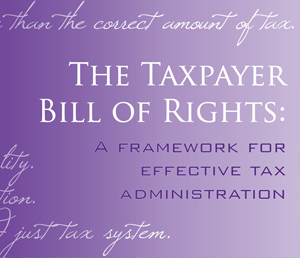The Internal Revenue Service has adopted a Taxpayer Bill of Rights that it said would become a cornerstone document to provide the nation’s taxpayers with a better understanding of their rights.
The Taxpayer Bill of Rights takes multiple existing rights that have already been included in the Tax Code and groups them into 10 broad categories, making them more visible and easier for taxpayers to find on IRS.gov.
Publication 1, Your Rights as a Taxpayer, has been updated with the 10 rights and will be sent to millions of taxpayers this year when they receive IRS notices on issues ranging from audits to collection. The rights will also be publicly visible in all IRS facilities for taxpayers and employees to see.
“The Taxpayer Bill of Rights contains fundamental information to help taxpayers,” said IRS Commissioner John A. Koskinen in a statement. “These are core concepts about which taxpayers should be aware. Respecting taxpayer rights continues to be a top priority for IRS employees, and the new Taxpayer Bill of Rights summarizes these important protections in a clearer, more understandable format than ever before.”
The IRS released the Taxpayer Bill of Rights following extensive discussions with the Taxpayer Advocate Service, an independent office inside the IRS that represents the interests of U.S. taxpayers. Since 2007, adopting a Taxpayer Bill of Rights has been a goal of National Taxpayer Advocate Nina E. Olson, and it was listed as the Advocate’s top priority in her most recent Annual Report to Congress.
“Congress has passed multiple pieces of legislation with the title of ‘Taxpayer Bill of Rights,’” Olson said. “However, taxpayer surveys conducted by my office have found that most taxpayers do not believe they have rights before the IRS and even fewer can name their rights. I believe the list of core taxpayer rights the IRS is announcing today will help taxpayers better understand their rights in dealing with the tax system.”
The Tax Code includes numerous taxpayer rights, but they are scattered throughout the code, making it difficult for people to track and understand. Similar to the U.S. Constitution’s Bill of Rights, the Taxpayer Bill of Rights contains 10 provisions. They are:
1. The Right to Be Informed
2. The Right to Quality Service
3. The Right to Pay No More than the Correct Amount of Tax
4. The Right to Challenge the IRS’s Position and Be Heard
5. The Right to Appeal an IRS Decision in an Independent Forum
6. The Right to Finality
7. The Right to Privacy
8. The Right to Confidentiality
9. The Right to Retain Representation
10. The Right to a Fair and Just Tax System
The rights have been incorporated into a redesigned version of Publication 1, a document that is routinely included in IRS correspondence with taxpayers. Millions of these mailings go out each year. The new version has been added to IRS.gov, and print copies will start being included in IRS correspondence in the near future.
The timing of the updated Publication 1 with the Taxpayer Bill of Rights is critical because the IRS is in the peak of its correspondence mailing season as taxpayers start to receive follow-up correspondence from the 2014 filing season. The publication initially will be available in English and Spanish, and updated versions will soon be available in Chinese, Korean, Russian and Vietnamese.





